Fastiv
Fastiv (Ukrainian: Фа́стів) is a city in the Kyiv Oblast (province) in central Ukraine. On older maps it is depicted as Chvastiv (Polish: Chwastów). Administratively, it is incorporated as a city of oblast significance. It also serves as the administrative center of the Fastiv Raion (district), to which it does not administratively belong. Its population is approximately 45,393 (2020 est.)[2] .
Fastiv
Фастів | |
|---|---|
City | |
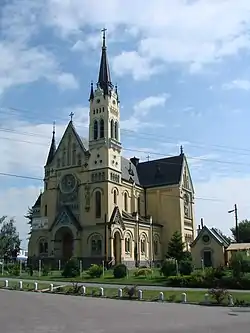 Holy Cross Cathedral | |
 Flag 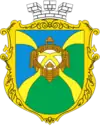 Coat of arms | |
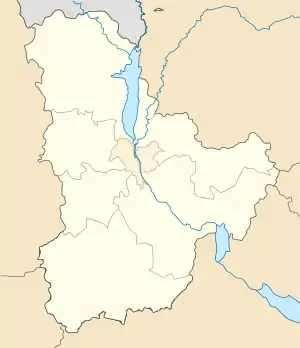 Fastiv 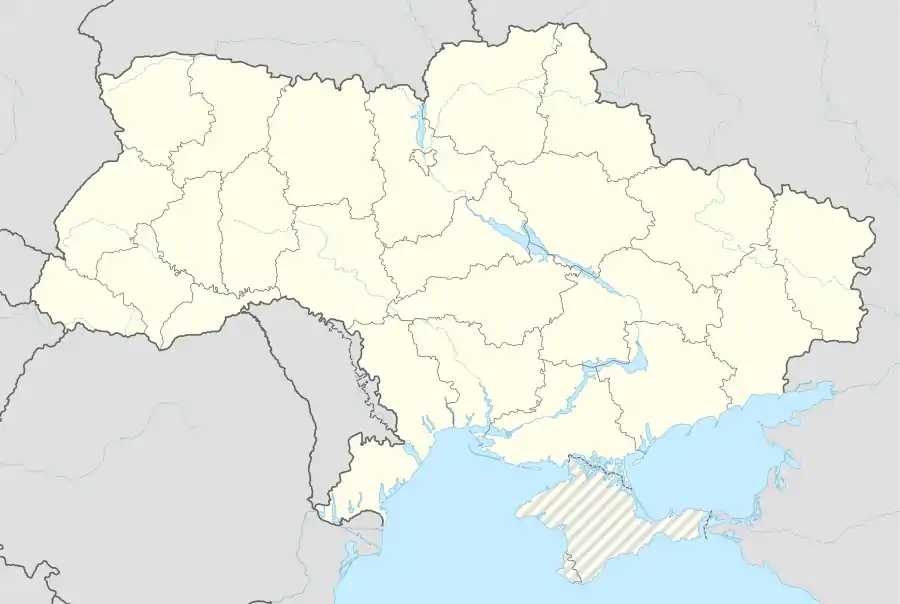 Fastiv | |
| Coordinates: 50°05′N 29°55′E | |
| Country | |
| Oblast | |
| Raion | Fastiv Raion |
| Founded | 1390 |
| Government | |
| • Mayor | Mykhailo Netyazhuk[1] (Party of National Selfishness[1]) |
| Area | |
| • Total | 43 km2 (17 sq mi) |
| Elevation | 199 m (653 ft) |
| Population (2020) | |
| • Total | 45,393 |
| • Density | 1,100/km2 (2,700/sq mi) |
| Time zone | UTC+2 (EET) |
| • Summer (DST) | UTC+3 (EEST) |
| Area code(s) | +380 4565 |
| Website | fastiv-rada |
Lying on conjunction of railway lines, Fastiv is an important node station on the rail route from central Europe to Russia and Asia. On 1 December 1918 at the Fastiv train station delegations of the Ukrainian People's Republic and the West Ukrainian People's Republic signed the Unification Act uniting territories of Ukraine that were split between Austrian and Russian empires.
Beside transportation industry, Brewing and machinery industry are also present, although the majority of inhabitants are employed by Ukrzaliznytsia's 12 railway installations in the city.
History
The foundation date of the city is not known. Under its current name the populated place is first mentioned as early as 1390 in old Russian chronicles where it is stated that Prince of Kyiv Vladimir Olgerdovich issued a certificate that stated that Fastiv belonged to Rozhanovsky princes.
Fastiv is a historical city that survived through many times Cossack uprisings and the Great Turkish War with the period of total devastation and later resettlement. In 1685 it became one of centers of revived Cossack movement in the Polish-Lithuanian Commonwealth following the Treaty of Andrusovo. In early 18th century around Fastiv took place Paliy uprising. Following the unsuccessful military campaign of Pylyp Orlyk in 1711, remnants of his military force withdrew to Fastiv after the 1711 siege of Bila Tserkva.
In the second half of 18th century, Fastiv was one of centers of another local uprising known as Koliyivshchyna.
In 1793 the town was ceded to the Russian Empire as part of the Second Partition of Poland and the complete Russian occupation of the Right bank Ukraine.
In 1825 during the Decembrist revolt in Saint Petersburg, the Imperial Russian troops quartered around Fastiv and Vasylkiv supported the revolt. In the mid 19th century around Fastiv, the Imperial Russian archaeological commission conducted archaeological excavations of the "Perepiat kurgan" which were attended by Taras Shevchenko as an experienced artist.
The loss in Crimean War, led to intensive development of railroad network throughout the Russian Empire and in 1870 through Fastiv was installed the Kiev–Odessa railroad.
As Chwastów (Fastów), it is mentioned in the 19th century Geographical Dictionary of the Kingdom of Poland being a town of the Vasylkiv county.
In 1898 Fastiv became a permanent residence of Imperial Russian inventor Nikolay Benardos out of the Central Ukraine who is known for developing of arc welding in the Russian Empire.
On 24 August 1919 the Ukrainian Galician Army defended Fastiv against hordes of Bolsheviks and few days later on 29 August 1919 the town residents were meeting the Head Otaman of the Ukrainian People's Republic forces Symon Petlura.
Soon after that in September 1919, a pogrom of the Jewish population of Fastiv was carried out by Denikin's White Army forces; about 1,800 people were murdered and about 8,000 died in the following year from wounds or epidemics.[3] In 1941 the German Einsatzgruppe C under Paul Blobel murdered all Fastiv Jews between the ages of 12 and 60.[4]
Architecture
Historical landmarks include the Intercession Church (Ukrainian: Pokrovska Tserkva; Intercession of the Theotokos Church) - a 17th-century Orthodox church, also known as Paliy Church (after the Cossack leader Semen Paliy). There is also an early 20th-century Catholic church.
Gallery
 One of names on maps (18th century)
One of names on maps (18th century) Information board about the "Museum on the wheels"
Information board about the "Museum on the wheels" City center and river bridge on an early 20th-century postcard.
City center and river bridge on an early 20th-century postcard. Unava River in Fastiv (early 20th-century postcard).
Unava River in Fastiv (early 20th-century postcard). Fastiv's brewery by the Unava River in early 20th-century (postcard).
Fastiv's brewery by the Unava River in early 20th-century (postcard). Fastiv's catholic church and its parish (early 20th-century postcard).
Fastiv's catholic church and its parish (early 20th-century postcard). Meeting of Symon Petlura at the Fastiv train station on 29 August 1919
Meeting of Symon Petlura at the Fastiv train station on 29 August 1919 Historic wooden church in Fastiv.
Historic wooden church in Fastiv. Fastiv's railway station (early 20th-century postcard).
Fastiv's railway station (early 20th-century postcard). Modern Fastiv-1 railway station: passenger terminal and the "Museum on wheels".
Modern Fastiv-1 railway station: passenger terminal and the "Museum on wheels". A street in the city centre.
A street in the city centre. A suburban train and the railway skyline.
A suburban train and the railway skyline. One of Fastiv's many railway intersections.
One of Fastiv's many railway intersections. Youth Park in Fastiv
Youth Park in Fastiv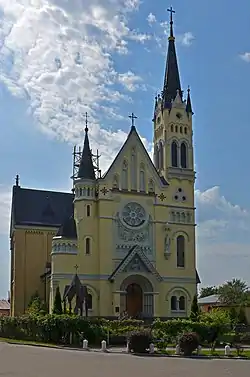 Holy Cross Cathedral
Holy Cross Cathedral
Town twinning
Notable people
- Ephraim Sklyansky (1892 - 1925), Soviet statesman and trotskyist.
- Jan Koum, CEO and co-founder of WhatsApp (with Brian Acton), a mobile messaging application which was acquired by Facebook Inc. in February 2014 for US$19 Billion.
References
- (in Ukrainian) The second round will be held in the city of Kyiv region: "servant" against the EU representative, Ukrayinska Pravda (2 November 2020)
- "Чисельність наявного населення України (Actual population of Ukraine)" (PDF) (in Ukrainian). State Statistics Service of Ukraine. Retrieved 30 September 2020.
- "The Murder of a Race". The Nation. 114. 8 March 1922.
- Yitzhak Arad (ed.): The Einsatzgruppen Reports. New York 1989, p. 129
External links
| Wikimedia Commons has media related to Fastiv. |
- Official website of the Fastiv City Council (in Ukrainian)
- Місто Фастів - City overview page (in Ukrainian)
- Історія міста City history page (in Ukrainian)
- "Chwastów". Geographical Dictionary of the Kingdom of Poland (in Polish). 1. Warszawa: Kasa im. Józefa Mianowskiego. 1880. p. 660.
